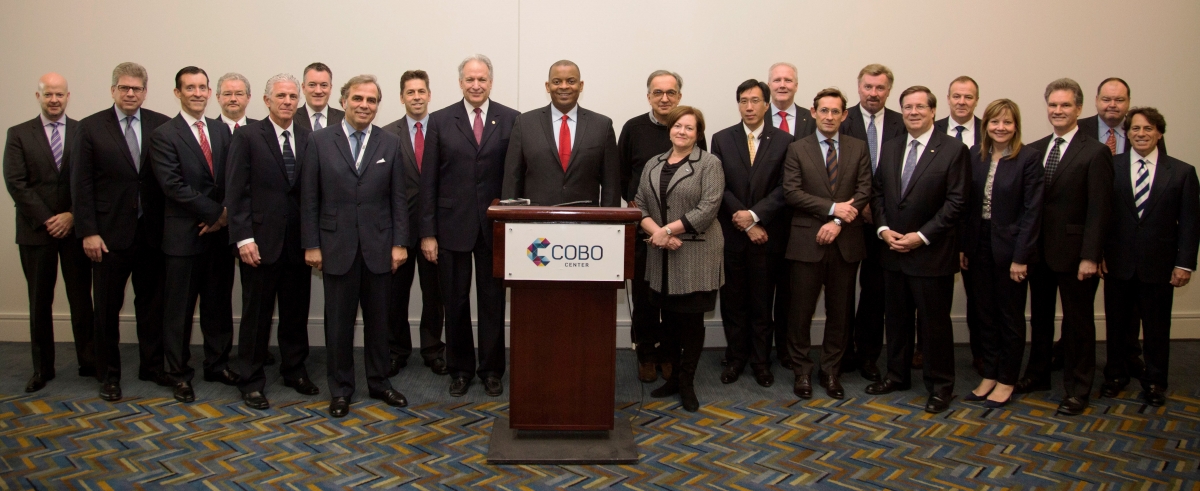Edmunds.com -- It's called the "silver tsunami": a huge wave of aging baby boomers that will build to its peak as that demographic enters its geriatric years. The 70-plus crowd is projected to increase from 30.1 million in 2013 to 53.7 million by 2030, according to the Insurance Institute for Highway Safety (IIHS), citing U.S. Census Bureau data.
This means there will be more aging drivers on U.S. roads in the coming years, continuing a trend that's been building for more than a decade. The IIHS estimated that the number of licensed drivers 70 years old and older jumped 30 percent between 1997 and 2012. Older drivers have also been traveling more miles. From 1996-2008, average yearly mileage for drivers 70 and older rose by 42 percent.
The IIHS notes that fewer people in their 70s are licensed to drive than are drivers between ages 20 and 69. And motorists in their 70s also log fewer miles than younger ones. But boomers are nevertheless keeping their licenses longer than previous generations and make up a bigger proportion of the driving population than in past years.
Help for Boomers Behind the Wheel
From music to medical care, baby boomers have exerted enormous influence on society and they will likely rewrite the rules of what it means to age and drive, too. But boomer drivers can't escape the toll that aging can take. AAA points out that nearly 90 percent of motorists age 65 and older suffer from health issues that may affect driver safety.
At the same time, however, mobility is important to mental health. For many aging people, driving is synonymous with independence.
"Helping seniors remain mobile with new technologies and a good car fit is important for quality of life," says AAA spokesman Michael Green. "Older Americans who have stopped driving are almost two times more likely to suffer from depression and nearly five times as likely to enter a long-term care facility compared to those who remain behind the wheel."
Fortunately, the technology that makes cars safer for everyone is arriving just in time to be particularly useful for aging motorists. Groups such as AAA and AARP offer resources that can help older drivers understand new technology and pick a vehicle that's best suited to their age and abilities.
"Older drivers should consider choosing vehicles that best meet their needs in order to improve safety and comfort behind the wheel," adds Green.
Read the rest of the story here: http://www.edmunds.com/car-technology/car-technology-that-helps-older-drivers.html
DOT, Automakers Agree on Proactive Safety Principles
This is a very exciting time for the auto industry. And I don't just mean the 2016 North American International Auto Show taking place in Detroit.
Yesterday, I announced DOT’s efforts in 2016 to support the safe deployment of autonomous vehicles that carmakers have been developing. And that includes President Obama's proposal to invest $4 billion in pilot programs [external link] to make sure we get it right. And next week, the President will visit Detroit to celebrate a history-making year of record auto sales.

Secretary Foxx walks the Detroit Auto Show with NHTSA Administrator Mark Rosekind.
But there's another side to what is happening in the industry. While we should celebrate the good news, there has been talk of another kind of record: Record numbers of vehicles recalled, and record civil penalties issued by our National Highway Traffic Safety Administration (NHTSA).
Fast Lane readers know the stories. And you might know that Congress recently passed legislation that strengthens NHTSA's enforcement tools. But, you probably also know that real safety means finding and fixing defects before someone gets hurt, rather than just punishing manufacturers after the damage is done.
So that's why I'm excited to announce that, today, DOT and 18 automakers are taking a strong stand --together-- for a new proactive, collaborative approach to safety.

Secretary Foxx, NHTSA Administrator Rosekind with automakers.
We have finalized a historic agreement on a set of broad-ranging actions to help make our roads safer and help avoid the sort of safety crisis that generates the wrong kind of record-setting and headlines. The commitments we make today will help catch safety defects before they explode into massive recalls. They will help improve the quality of data that automakers and NHTSA analyze to identify defects today, and they will find ways to generate better data in the future.
DOT has experience with this kind of approach. In aviation, for example, we already have a model of industry-wide collaboration to support safety. The FAA’s safety management system (SMS) requires a willingness among the airlines to share safety data that can lead to discovering a defect before it hurts anyone. And this has dramatically reduced aviation accidents in our skies.
And, when a recall does become necessary, the commitments we're making today will help us reach consumers and get their vehicles repaired.
Additionally, today’s actions strengthen the industry's efforts to protect vehicle owners from cybersecurity risks. We all know that the performance today's vehicles achieve is due in large part to an increasing amount of computer hardware and software under the hood and behind the dashboard. And the era of automated vehicle technologies we're ushering in will add to that. So we have pledged to work collaboratively to mitigate cyber threats that could pose unreasonable safety risks. We will engage our best cybersecurity minds, share known vulnerabilities and countermeasures, and adopt best practices from within as well as outside of the auto industry.
This coming together of the global automotive industry with DOT and NHTSA to determine how we can make vehicles that are safer than ever before and even safer in the future --this is unprecedented. It was born of us gathering everyone in the same room last fall, and it was the product of an immense amount of work by the companies who have signed onto these principles and by our team at DOT.
It’s a new way of doing business for everybody, and new ways don’t come easily. But that's what you have to do to when the mission you share --making sure Americans can get safely to and from their destination every time they get in their car-- is so important.
You can read this historic agreement at www.transportation.gov/briefing-room/proactive-safety-principles-2016
USA Today -- Don't send your old clunker of a retro-mobile to the automotive junk yard just yet. It may be the safest machine on the road.
In an article published Tuesday, Wired magazine reports on how it engaged two hackers to see if they could take control of a Jeep Cherokee from the comfort of their living room while writer Andy Greenberg sat nervously at the wheel while the SUV cruised the highway at 70 mph.
Mission accomplished, terrifyingly so. The security experts, Charlie Miller and Chris Valasek, accessed the Jeep's computer brain through its Uconnect infotainment system and rewrote the firmware to plant their malicious code. Once in, the duo began blasting hip-hop through the stereo system, turned the AC to maximum and, ultimately, killed the transmission and brakes.
Greenberg was unharmed in the demonstration, which took place on a highway in St. Louis, but eventually wound up stranded in a ditch. But the experiment highlights a concern that often isn't addressed head-on in the growing excitement over the prospect of roads dominated by either autonomous or heavily driver-assisted vehicles.
If the frequent attacks on myriad retail and financial institutions tell us anything, it's that there isn't a digitally connected network that is completely safe from hackers. And while it's one thing to have to change credit cards due to a breach, it's another to be trapped in a speeding hunk of metal when the crippling intrusion happens.
Says Miller, a security researcher for Twitter and a former National Security Agency hacker: "If consumers don't realize this is an issue, they should, and they should start complaining to carmakers. This might be the kind of software bug most likely to kill someone."
Read the rest of the story here: http://www.usatoday.com/story/tech/2015/07/21/hack-connected-car-raises-alarm-over-driver-safety/30462317/
While self-driving cars already are being tested on public roads, newly released safety data support the cautionary view that the technology has many miles to go before people can sleep at the wheel.
That doesn’t mean relief is decades away for drivers weary of commuting. It’s possible, even likely, that within a few years mainstream cars will be able to drive themselves reliably — on routes they have mastered, in weather they can handle and on the premise that a driver will be ready to take over when needed. (The White House last week said it will work with auto companies and state governments to speed up the arrival of driverless cars.)
Traditional automakers and technology companies such.. read more
Forbes -- Automakers are introducing new, high-tech features considerably faster than many drivers can learn how to use them or even fully understand what they do, according to a couple of recent studies.
But even older consumers see the value in some of the newer features, especially blind-spot warning systems and back-up cameras, according to research from The Hartford insurance company and the Massachusetts Institute of Technology Age Lab.
Nearly all of the respondents in a Hartford/MIT study of drivers ages 50 to 69 said they would be willing to buy a car with at least one of the seven auto technologies in the study: back-up cameras, blind-spot warning systems, collision avoidance systems, lane departure warning systems, smart headlights, parking assistance and adaptive cruise control.
That list is in order of preference, in terms of being linked to safety. Back-up cameras, blind-spot warning systems and collision avoidance were the highest rated.
Collision avoidance systems can bring a car to a complete halt if sensors detect the distance to the car ahead is shrinking too fast, and if the driver either ignores a warning alarm or doesn’t brake hard enough. “Smart” headlights turn the beams in tandem with the steering wheel.
Parking assistance, used in parallel parking only, measures the size of a parking place and moves the steering wheel to direct the car into a space. The driver has to apply the brake and shift when needed.
Read the rest of the story here: http://www.forbes.com/sites/jimhenry/2015/11/28/older-drivers-are-ok-with-tech-features-if-they-improve-safety/?mc_cid=78f79c9d41&mc_eid=4c2ab888bb
North Andover, MA – September 17 , 2020 – Mobile Electronics Magazine features great information for Selling Vehicle Safety Systems for Advanced Driver Assistance Systems (ADAS) brought to you from the Vision Zero Automotive Network.
Words by Dave MacKinnon













